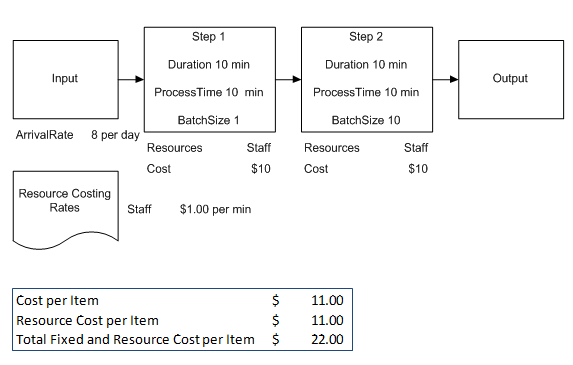When arriving items are processed one-at-a-time (BatchSize = 1), the ‘per execution’ and ‘per item’ statistics will be of equal value. When batch processing is being practiced, however, the key performance indicators shown below will have different per execution and per item values; these provide different views of performance.
ProcessTime, Cost, Resource Costs, User Property Costs, Total of All Costs
Consider the following simple example.

The time to execute these steps is the time to process a batch of 1 at Step 1 plus the time to process a batch of 10 at Step 2; the total process time to execute these steps is 20 min. [(10 min / batchsize 1) + (10 min / batchsize 1)].
The effective processing time per arriving item is the sum of the ‘per item’ processing times at Step 1 and Step 2. The process time per item at Step 1 is 10 minutes. [ProcessTime = 10 / BatchSize = 1]. The process time per item at Step 2 is 1 minute.
[ProcessTime = 10 / BatchSize = 10]. The total ProcessTime per Item is 11 minutes.

At the activity level, the Process Time per Item is equal to the ProcessTime per Execution divided by the BatchSize. At the process level, the Process Time per Item represents the sum of the activity probability-weighted ProcessTime per Item values.
The cost statistics are also impacted by batch processing. At the activity level, the Cost per Item is equal to the Cost per Execution divided by the BatchSize. At the process level, the Cost per Item represents the sum of the activity probability-weighted Cost per Item values.

It’s important to note that if there is a desire to demonstrate the amount of work involved or cost incurred to process a specific number of arrival items that the ‘per item’ statistics should be used in the calculation. (The resource cost to process 100 items from Input to Output through Step 1 and Step 2 in the example above is 100 * $11 = $1,100, not 100 * $20 = $2,000.)

